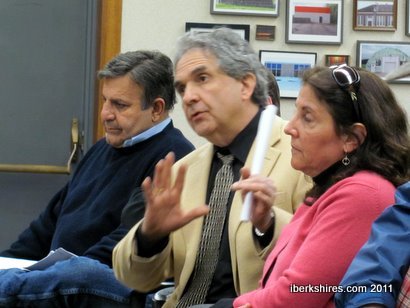| Home | About | Archives | RSS Feed |

Finance Committee Gets School Building Run Down
|
Finance Committee Chairman Michael Bloom, left, member David Bond and Mayor Richard Alcombright listens to Superintendent James Montepare explain the school building project. |
NORTH ADAMS, Mass. — The school officials are waiting for the Massachusetts School Building Authority to give it the nod before presenting a school building plan to the public.
The School Building Committee indicated its preference last month for renovating Conte School and building a new Greylock School, both to serve kindergarten through seventh grade. However, School Committe members and city councilors expressed annoyance with the decisionmaking process, saying it has not been transparent enough and the two policy making bodies have not been kept in the loop.
 Mayor Richard Alcombright, chairman of the School Committee, said hearings and presentations on the favored option will be held as the project moves forward but no decision has been made it yet.
Mayor Richard Alcombright, chairman of the School Committee, said hearings and presentations on the favored option will be held as the project moves forward but no decision has been made it yet.
"We want to have dicussions surrounding what is rather than what if's," he told the Finance Committee on Tuesday. "There's too many what if's out there."
Superintendent of Schools James Montepare said until the MSBA approves a plan, "it's very difficult for us to do anything but speculate on what it could possibly be ... it could be all kind of misinformation."
Montepare gave the Finance Committee an update on the process, including the options reviewed by the School Building Committee last month. They included building a new Greylock and renovating Conte; building a single school for 620 children, most likely where the current Greylock is located or revamping Conte for 620, and renovating Greylock and Sullivan School, which was deemed the most difficult because of the topography of the Sullivan site.
Should the Conte/Greylock project go forward, Sullivan School would close. Montepare said of all the school structures, Sullivan would likely be the easiest to market becuase of its condition and location. It would, the mayor thought, make a good assisted-living facility or terraced residences.
The options are dependent upon the MSBA accepting the city's new educational structure of kindergarten through seventh and eighth through 12th grade.
There had been concern about returning the middle school students to the elementary schools after Conte's closure two years ago, but the new configuration had worked out well, said Montepare.
"We had some very unexpected and positive results of that move," said superintendent. Moving the eighth grade to the high school has enabled the class to participate in accelerated programs, sports, music and other activities. It's also not only stemmed a flow outward of city students to neighboring schools but has dramatically increased school choice students coming in to attend eighth grade.
"We've seen a lot of discipline problems disappear and we've increased population," said Montepare. The school system has had a lot of internal discussions among teachers and various programs, he said, and the preference has tended to for Conte and Greylock.
The MSBA has indicated it also likes the idea of renovating Conte; it is expected to select which option it prefers by the end of the month.
After that, things will start moving faster, said the mayor, and public hearings will be scheduled along with more detailed discussions about the cost. The MSBA will reimburse the city 80 percent for qualifying costs upfront; the balance, estimated at under $10 million for two schools, would be bonded for 20 or 30 years.
Montepare gave an opening date of the 2013 school year. Current debt payments of $250,000 annually on the reconstructions of Drury High School and Brayton School should be "rolling off" about then, said the mayor, who gave an off-the-cuff guess of $450,000 to $500,000 to pay for two new or revamped schools.
Frequent critic Robert Cardimino questioned whether the city or state could afford the schools.
"We went through this for each school when the budget was very, very tight and the decison was made not to pass up on the state money and we found a way to pay for it and we did the right thing," said committee Chairman Michael Bloom. "We built two beautiful schools ... we should not walk away from this money either. You can't walk away from 80 percent funding."
How the costs will be absorbed would be part of the upcoming discussions, said Alcombright. It's possible it could be done as a debt exclusion, he said, which would put the decision into the public's hands.
"To say yes to the project the community will have to say yes to pay for it.


